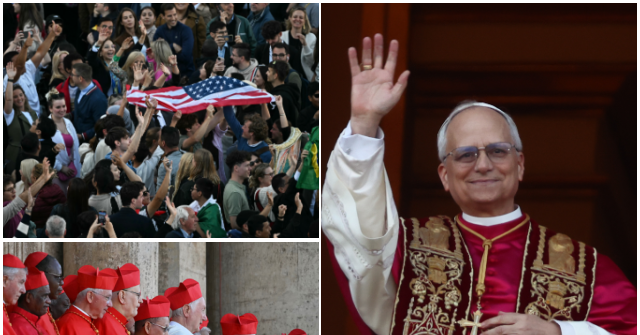Cardinal Robert Francis Prevost of Chicago was chosen by the College of Cardinals to be the new pope of the Catholic Church, making him the first American pope in the Church’s 2,000-year history. The Chicago native chose the papal name Leo XIV. White smoke appeared above the Sistine Chapel at approximately 6:08 p.m. Rome time, followed by the chiming of the Vatican’s bells, which confirmed that a new successor of St. Peter the Apostle was indeed chosen.
**Live updates below. All times Pacific.**
11:30 p.m. — The Empire State Building is lit up in gold and white tonight in honor of the first American pope.
11:22 p.m. — To his friends, he was just “Bob” who watched Chicago Bulls games and is “an unambitious person, both reserved and prayerful,” according to The New York Times, which interviewed two priests who are old friends of the new pope:
Another longtime friend, the Rev. Robert Hagan, said that Robert Prevost was his mentor and superior when he was studying to become a priest in Racine, Wis., in the late 1990s.
They watched Chicago Bulls games together, and over the years checked in about the success of the men’s basketball team at Villanova, which they both attended.
“He had a twinkle in his eye, a serenity in his face. He’s a man who is centered. He wasn’t about the drama. He was calm,” said Father Hagan, who is now prior provincial in charge of the St. Augustinian order in the Philadelphia area.
Hours after the new pope was announced, Father Hagan still had trouble keeping his friend’s new name straight. “I think of him as Bob,” he said, adding that he was trying to retrain himself. “When he appeared on that balcony, it was as if a family member appeared.”
11:20 p.m. — I have something in common with the new pope. We both love Wordle:
8:25 p.m. — This is a good explanation of what it means to be an Augustinian like the new pope, who, as a priest, was a member of the Order of Saint Augustine (OSA). The Augustinians are a mendicant religious order founded in 1244 that follows the Rule of St. Augustine of Hippo, the great 4th century saint and doctor of the Church whose famous memoir, Confessions, is a quintessential text of philosophy, theology, and world literature.
8:14 p.m. — It’s said that no matter where a pope comes from, he becomes a Roman in the end. The people of Rome are already claiming Leo XIV as their own.
7:59 p.m. — The moment when a future pope met the pope:
7:36 p.m. — Undeterred, the Chicago Cubs continue to claim the new pope as their own.
“Hey, Chicago. He’s a Cubs fan!” reads the Wrigley Field marquee in Chicago on Thursday, May 8, 2025, after Cardinal Robert Prevost, a Chicago native, was chosen as the 267th pontiff. (Armando L. Sanchez/Chicago Tribune/Tribune News Service via Getty Images)
7:23 p.m. — Pope Leo XIV reportedly has a deep and long-standing commitment to the pro-life movement.
7:19 p.m. — Yes, the new pope is definitely a White Sox fan.
4:35 p.m. — The new pope is a graduate of Villanova, and the university is over the moon today.
And we have his yearbook photo:
The memes are so good…
4:23 p.m. — Bishop Barron, also a Chicago native, has some interesting commentary here on the new pope:
4:16 p.m. — Uh-oh. We have a correction. Pope Leo XIV is apparently a White Sox fan, not a Cubs fan, according to his brother. But the new pope’s mother was a Cubs fan.
4:00 p.m. — Here is a film clip shot in 1896 of the last pope named Leo:
2:30 p.m. — Here is an English translation of the full transcript of Pope Leo XIV’s first address:
Peace be with all of you! Dearest brothers and sisters, this is the first greeting of the Risen Christ, the Good Shepherd who gave His life for God’s flock.
I, too, would like this greeting of peace to enter your hearts, to reach your families, and all people, wherever they are, all of the people, all over the earth.
Peace be with you!
This is the peace of the Risen Christ, an unarmed peace and a disarming peace, humble and persevering. It comes from God, God who loves us all unconditionally. We still have in our ears that weak, but always courageous voice of Pope Francis as he blessed Rome!
The Pope who blessed Rome, gave his blessing to the world, to the entire world, that Easter morning. Allow me to follow up on that same blessing: God loves us, God loves you all, and evil will not prevail!
We are all in the hands of God.
Therefore, without fear, united hand in hand with God and among ourselves, we move forward. We are disciples of Christ.
Christ precedes us. The world needs His light. Humanity needs Him as the bridge to allows it to be reached by God and by His love.
Help us, too, and help each other to build bridges, with dialogue, with meetings, uniting us all to be one people, always in peace. Thank you, Pope Francis! I also want to thank all my brother cardinals who have chosen me to be Peter’s Successor, and to walk together with you, as a united Church always seeking peace, justice, always seeking to work as men and women who are faithful to Jesus Christ, without fear, to proclaim the Gospel, to be missionaries.
I am a son of Saint Augustine, an Augustinian, who said: “with you I am a Christian and for you I am a bishop.” In this sense, we can all walk together towards that homeland that God has prepared for us.
To the Church of Rome, a special greeting! We must seek together how to be a missionary Church, a Church that builds bridges, dialogue, always open to receive like this square with its open arms, all, all who need our charity, our presence, dialogue, and love.
And if you allow me a word, a greeting to all and especially to my beloved diocese of Chiclayo, in Peru, where a faithful people accompanied their bishop, shared their faith and gave so, so much to continue being a Church that is faithful to Jesus Christ.
To all of you, brothers and sisters of Rome, of Italy, of the whole world, we want to be a Church of the Synod, a Church that walks, a Church that always seeks peace, that always seeks charity, that always seeks to be close, especially to those who suffer.
Today is the day of the Supplication to Our Lady of Pompeii. Our Mother Mary always wants to walk with us, to be close, to help us with her intercession and her love. So, I would like to pray together with you. Let us pray together for this new mission, for the whole Church, for peace in the world and let us also ask Mary, our Mother, for this special grace.
[Began the recitation of the Hail Mary in Latin.]
1:41 p.m. — Here’s some excellent news. The new pope has the right enemies:
1:03 p.m. — Next year, the United States will celebrate the 250th anniversary of our founding, and there will be an American pope — what an amazing trajectory for our young country.
1:00 p.m. — The new pope gets a shout out from another famous Chicagoan:
12:50 p.m. — Here are some quick facts about the new pope, including the fact that he has a degree in mathematics from Villanova University:
12:24 p.m. — Here’s one we didn’t see coming — the new pope riding a mule. The photo comes from his Facebook page. (Yes, we now have a pope of the social media age).
11:58 a.m. — The new pope, born and raised in Chicago, is, of course, a Cubs fan.
11:56 a.m. — Bishop Robert Barron encourages everyone to pray for the new pope.
11:53 a.m. — Fox News’ David Asman reports that the Star Spangled Banner was played at St. Patrick’s Cathedral in New York City after noon mass today. Who could have guessed a few hours later, we’d learn that we have an American pope.
11:45 a.m. — Americans were celebrating the new pope in St. Peter’s Square.
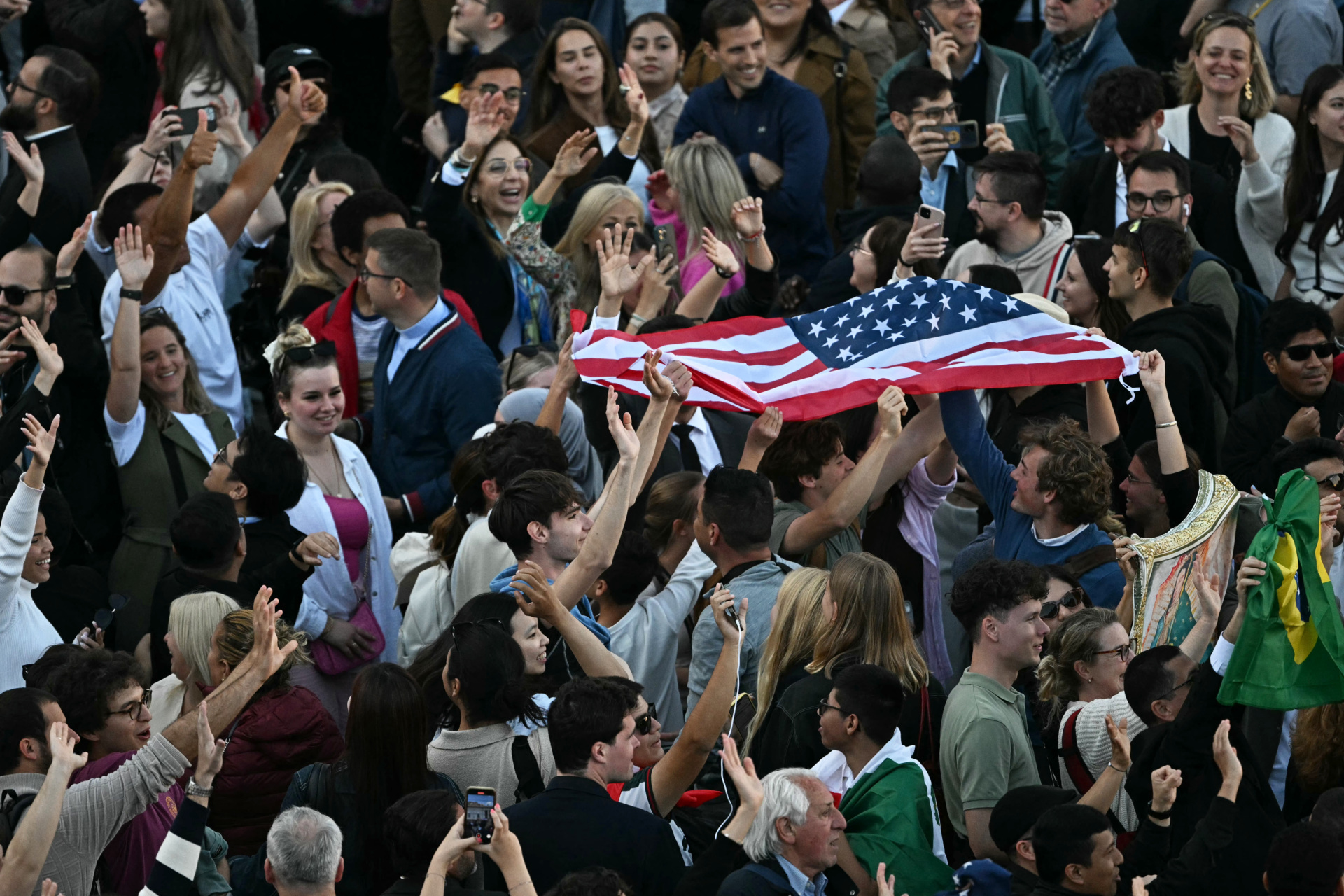
People display the American flag at St Peter’s Square as the cardinals signaled they elected a new pope on May 8, 2025. (GABRIEL BOUYS/AFP via Getty Images)
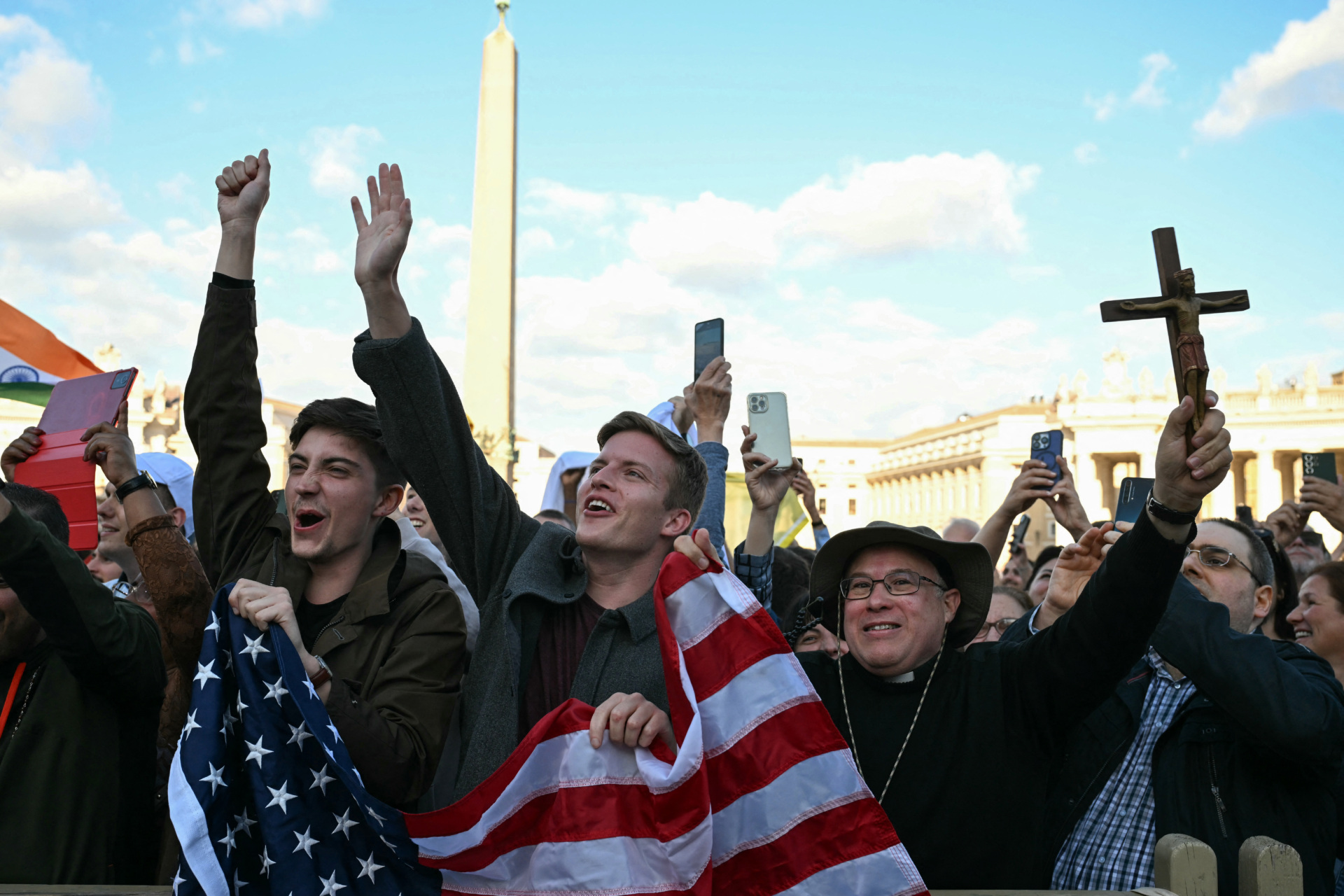
Americans react to the election of the new pope at Saint Peter’s Square in The Vatican, on May 8, 2025. (STEFANO RELLANDINI/AFP via Getty Images)
And the news hit New York City..
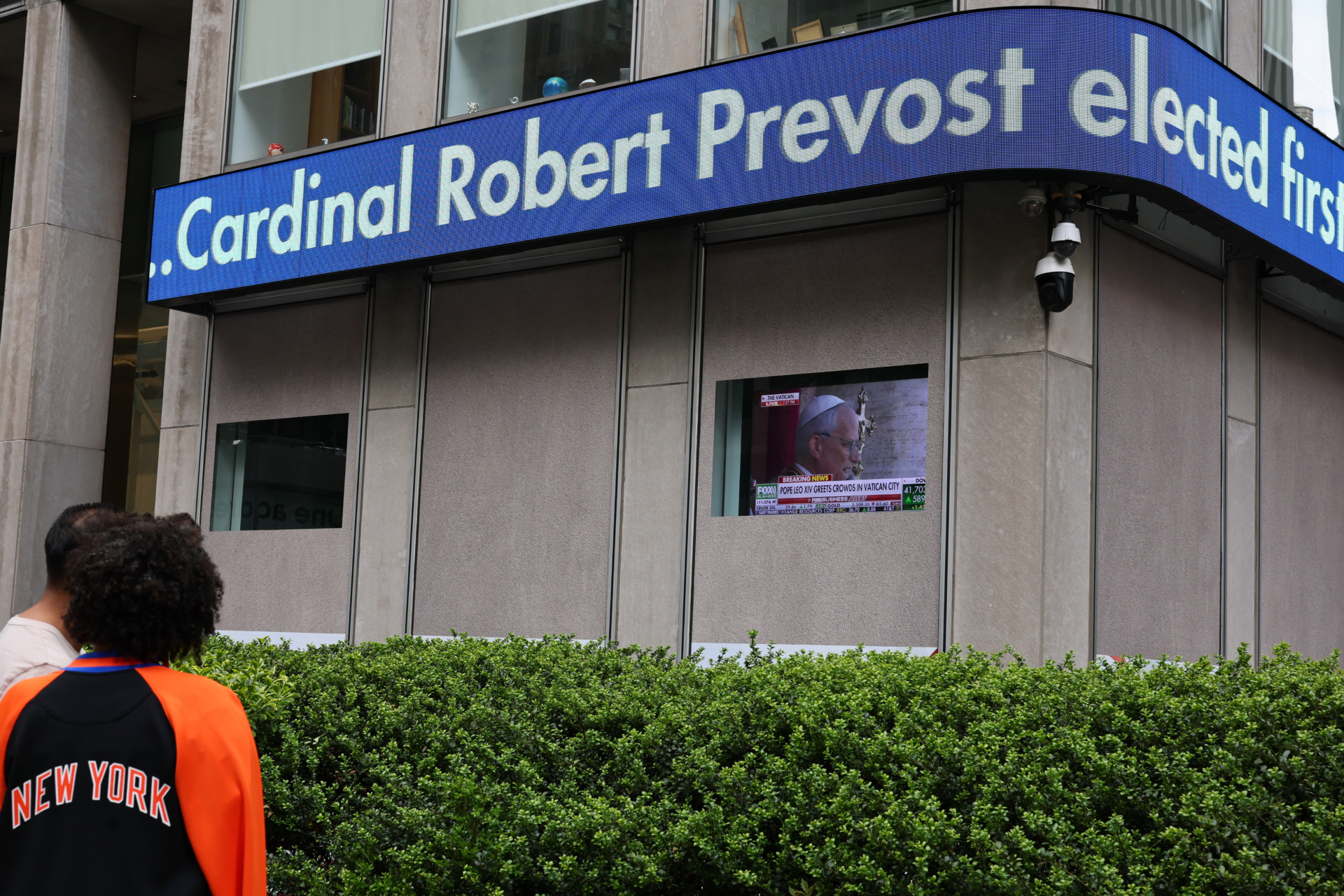
People watch news of the election of Cardinal Robert Prevost as the new pope at the Fox News corporation headquarters on May 8, 2025 in New York City. (Michael M. Santiago/Getty Images)
11:17 a.m. — There is already a great deal of speculation about whether Pope Leo XIV will be a “Francis 2.0” papacy. It is, of course, too soon to tell; but his choice of name and the traditional vestments he wore may give some indication about where he stands.
His past statements don’t indicate a wokeness on certain social issues.
11:14 a.m. — Though Cardinal Prevost was listed on the “papabili” lists, he was not seen as a likely contender due to his being an American. The conventional wisdom has always been that an American pope was unlikely so long as the United States is a super power because it might look like the Americans are running both the state and the church, so to speak. That makes Pope Leo XIV’s election to the See of St. Peter all the more remarkable.
The media is already scrambling to glean clues about his stances on moral and theological issues. Charlie Kirk did find a clue about his voting record as an American citizen. Make of this what you will:
On the other hand, the Daily Wire’s Matt Walsh cautions about reading too much into this sort of thing.
I would quibble with one small point in Walsh’s tweet. All things are “ordained by God” in the most general sense, but the pope is specifically selected by the Cardinals. The late Pope Benedict XVI made clear that, although it is hoped that the Cardinals will seek the Holy Spirit’s guidance in their decision, the Cardinals are the ones deciding; and the long history of the Church indicates that they have sometimes decided on bad popes. This is not to say that the new pope is one of those bad choices. This is just to affirm St. Paul’s wisdom when he wrote that “we hold this treasure in earthen vessels.” (2 Corinthians 4:7).
The new pope does appear to have been a confidant of Pope Francis, but many are speculating that he was the Conclave’s centralist choice between the progressive faction represented by Pope Francis and the traditionalist faction represented by Cardinals Burke and Sarah. Whether that will be true in practice is hard to say.
11:02 a.m. — President Trump has issued a statement congratulating the new pope and celebrating the fact that he’s an American.
“Congratulations to Cardinal Robert Francis Prevost, who was just named Pope,” Trump wrote “It is such an honor to realize that he is the first American Pope. What excitement, and what a Great Honor for our Country. I look forward to meeting Pope Leo XIV. It will be a very meaningful moment!”
11:01 a.m. — Peo Leo XIV noted his Augustinian background and its importance to his theology. The Catholic website College of Cardinals provides more biographical information on that here:
His educational background includes a Bachelor of Science in Mathematics from Villanova University in 1977, a Master of Divinity from Catholic Theological Union in Chicago, and both a licentiate and doctorate in canon law from the Pontifical College of St. Thomas Aquinas in Rome. His doctoral thesis was on “The role of the local prior in the Order of Saint Augustine.”
His career in the Church has been marked by significant roles and achievements. After his ordination as a priest in 1982, Prevost joined the Augustinian mission in Peru in 1985 and served as chancellor of the Territorial Prélature of Chulucanas from 1985 to 1986.
He spent the year 1987 to 1988 in the United States as pastor for vocations and director of missions for the Augustinian Province of Chicago before returning to Peru where he spent the next ten years heading the Augustinian seminary in Trujillo and teaching canon law in the diocesan seminary, where he was also prefect of studies. He also served in other capacities there, including as a parish pastor, diocesan official, director of formation, seminary teacher, and judicial vicar.
10:39 a.m. — The new pope spoke to the crowd in Latin, Italian, and Spanish, but not in his native English.
His choice of Leo as a papal name is an interesting choice that perhaps is meant to evoke the beloved Leo XIII, who wrote the great 1890 encyclical Rerum novarum, which championed the rights of workers in a changing world and is often heralded by Catholics as a populist document that advocates for the rights of the common man.
Breitbart’s Jim Pinkerton wrote about the importance of Rerum novarum in a 2019 Labor Day essay by highlighting an op-ed in which then-Senator — and current Trump Secretary of State — Marco Rubio invoked Rerum novarum:
And here, just in time for Labor Day, Marco Rubio has performed a public service. The Florida senator has recalled one important source of inspiration about the value of labor, namely, the Catholic social teaching of the 19th and 20th centuries.
In a piece entitled “What Economics Is For,” Rubio began by recalling some valuable history:
Almost 130 years ago, Pope Leo XIII published the encyclical Rerum Novarum. In this text, he defended the well-being of workers and made the Catholic Church’s position on work clear: Work and working people have a fundamental dignity that all societies are bound to respect and serve. “No man,” the pope wrote, “may with impunity outrage that human dignity which God Himself treats with great reverence.”
One needn’t be Catholic to see the wisdom here: The pope’s words are, in their way, just a reworking of the Golden Rule.
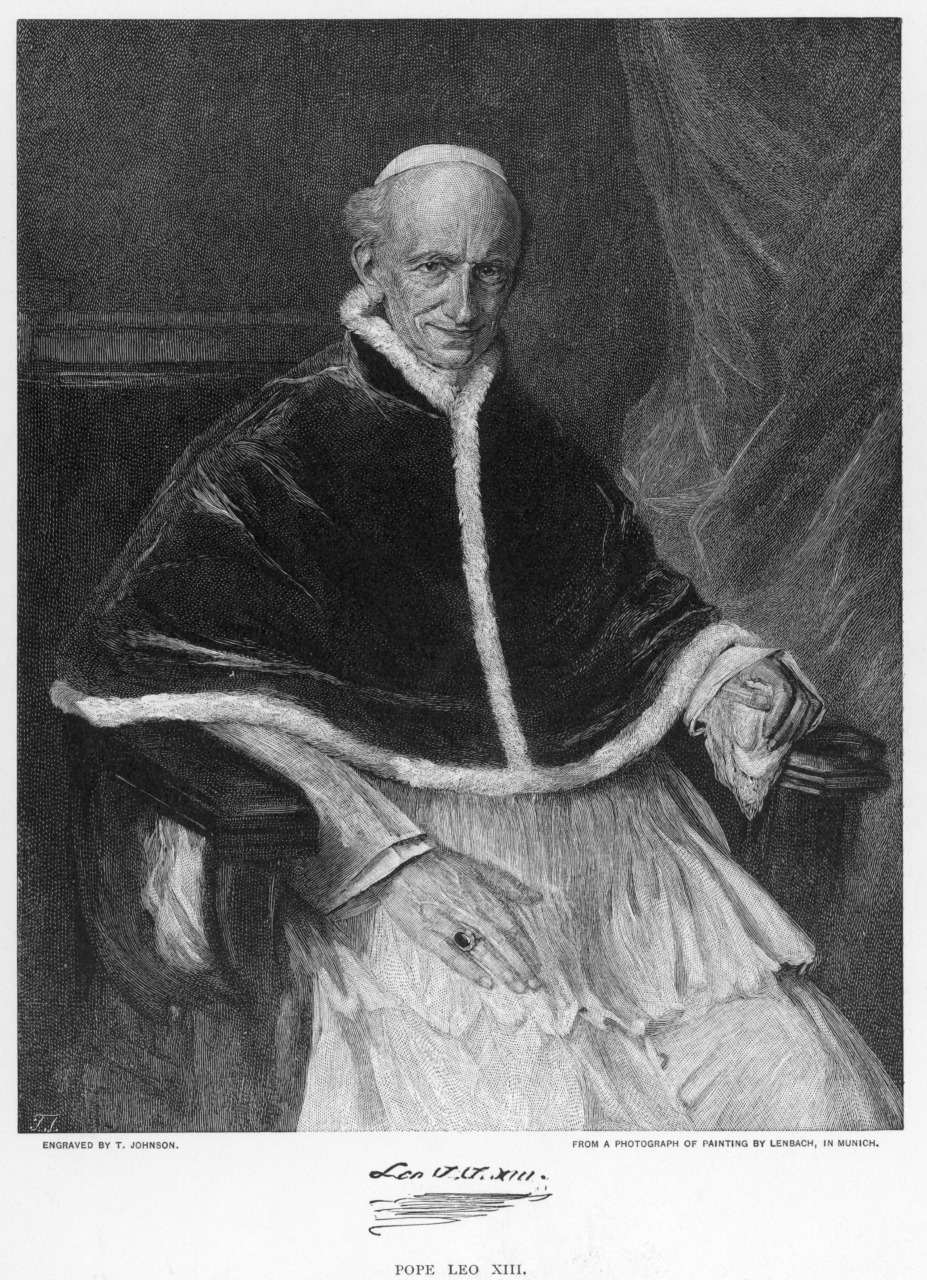
Pope Leo XIII (1810-1903), whose encyclical “Rerum Novarum” (or “Rights and Duties of Capital and Labor”) defended private property and the rights of workers to form unions, while also condemning socialism and unrestricted capitalism. (Hulton Archive/Getty Images)
Moreover, it’s no coincidence that Leo’s Rerum Novarum (“Of New Things”) appeared in 1890—which is to say, at around the same time that the U.S. established Labor Day. In that era, factories and mass production were churning the old agricultural economy, dislocating ancient folkways, and creating new kinds of economic challenges, as well as, of course, new opportunities. Amidst all this flux, people were understandably desperate to find ways to re-establish social equilibrium.
And yet precisely because the old conservative political system was failing to maintain a just order, radical alternatives—including anarchism, socialism, and communism—were gathering strength.
In response, enlightened leaders in the center stepped in, realizing that new and creative thinking was needed to fend off revolution.
As Rubio explains, Leo XIII was one of these reformers; theologically, he was a conservative, and yet politically, he was a moderate. Even though he had no formal political power, he nevertheless used his influence to urge secular leaders to chart a middle course, steering between the radical left and the reactionary right. And in particular, the Holy See believed that workers had rights—including the right to organize themselves for their betterment. As Rubio explains:
The Church’s tradition cuts across identitarian labels, insisting upon the inviolable right to private property and the dangers of Marxism, but also the essential role of labor unions.
As we all know, the 20th century was marred by hideous man-made disasters, and yet the creation of stabilizing middle classes in many countries is in part a testament to the enduring influence of Leo and Rerum. Rubio continues:
The dignity of work, the Church instructs us … is not just the concern of individuals. It is the concern of communities and nations to provide productive labor to their people.
10:26 a.m. — “Peace be with you all!” he opened. And then offered his blessing to the crowd. “This is the peace of Christ risen from the dead. God is close to you all.” He mentions the late Pope Francis and says that he wishes to give his blessing to the world the way Francis did and says,”We are all beloved of God. For that reason, let us be united as disciples of Jesus Christ.” He also thanked his fellow cardinals. He mentions being missionaries of the gospel. He notes that he is an Augustinian — following the order of St. Augustine. He gives a special greeting to the Diocese of Rome, which is now his specific diocese. He speaks of embracing everyone just as the famous architecture of the colonnades of St. Peter’s Square embraces the faithful. He then prays the Hail Mary in Italian and asks for the protection of the Madonna (a tried and true way to win over his Italian flock).
The new pope now offers his Urbi et Orbi blessing.
10:23 a.m. — And here he comes. Pope Leo XIV in his white cassock addresses the faithful for the first time. He will now address the crowd and give his first “Urbi et Orbi” blessing. The term in Latin means “to the city [of Rome] and to the world.”
10:20 a.m. — The new Pope Leo XIV is obviously the first pope from the United States. The Catholic website College of Cardinals has more information on his background here.
10:13 a.m. — “Habemus Papam!” the dean of the College of Cardinals has announced. It’s an American! Cardinal Robert Francis Prevost of Chicago who chose the name Pope Leo XIV.
10:06 a.m. — The faithful are packing into St. Peter’s Square awaiting the announcement. Flags from around the world can be seen, confirming the universal nature of the Catholic Church and its over 1.4 billion faithful from every corner of the earth. The diverse crowd also looks young.
9:47 a.m. — The new pope was likely chosen on the fourth ballot on the second day, which was the same number of ballots and days in which Pope Benedict XVI and Pope John Paul I were chosen in 2005 and 1978 respectively.
9:31 a.m. — The Swiss Guards and band are moving into place for the announcement of the new pope.
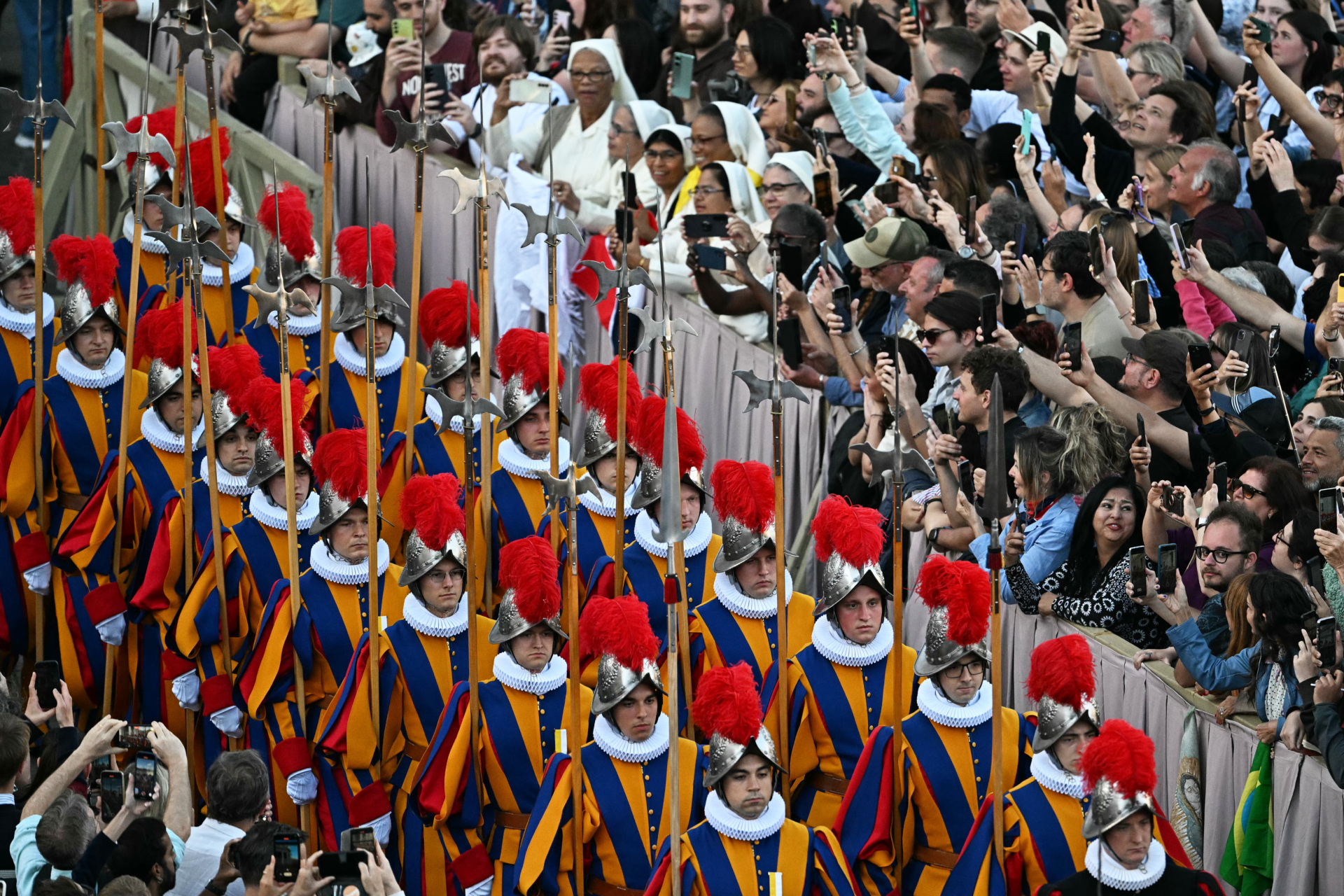
Swiss Guards and music band enter the parvis of St Peter’s basilica before the first appearance of the new Pope, after the cardinals ended the conclave, in The Vatican, on May 8, 2025. (GABRIEL BOUYS/AFP via Getty Images)
6:08 a.m. — White smoke was seen from the Vatican at approximately 6:08 p.m. Rome time, signaling that the Cardinals have elected a new pope of the Catholic Church. The chiming of the Vatican’s church bells confirmed for the faithful gathered in St. Peter’s Square that a new successor to the See of St. Peter the Apostle has indeed been chosen. The world now waits for the Cardinals to announce who the new pope is and what name he has chosen to be known by.
Photos from St. Peter’s Square:
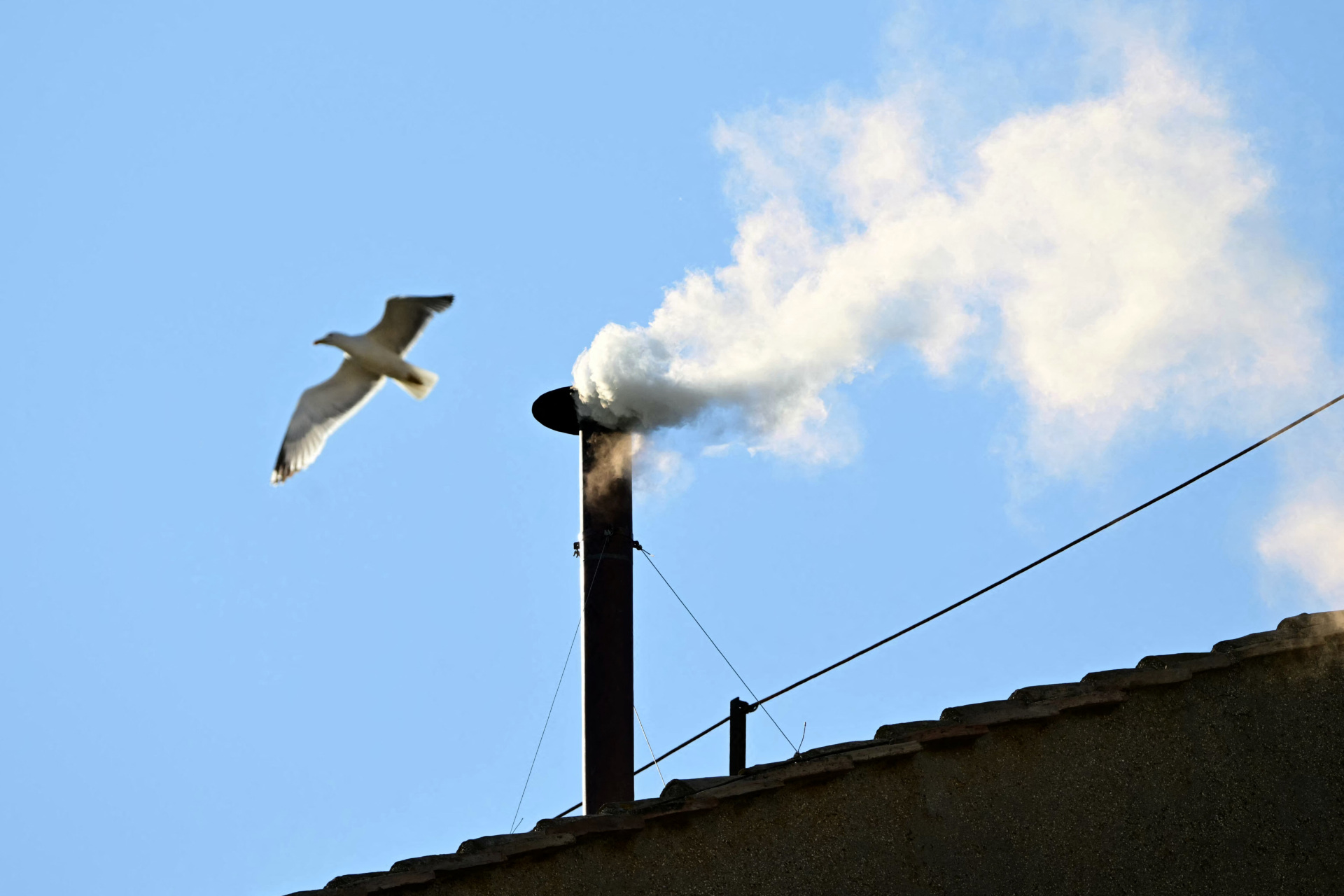
This photograph shows white smoke rising from the chinmey of the Sistine Chapel signaling that cardinals elected a new pope during their conclave in the Vatican on May 8, 2025. (TIZIANA FABI/AFP via Getty Images)
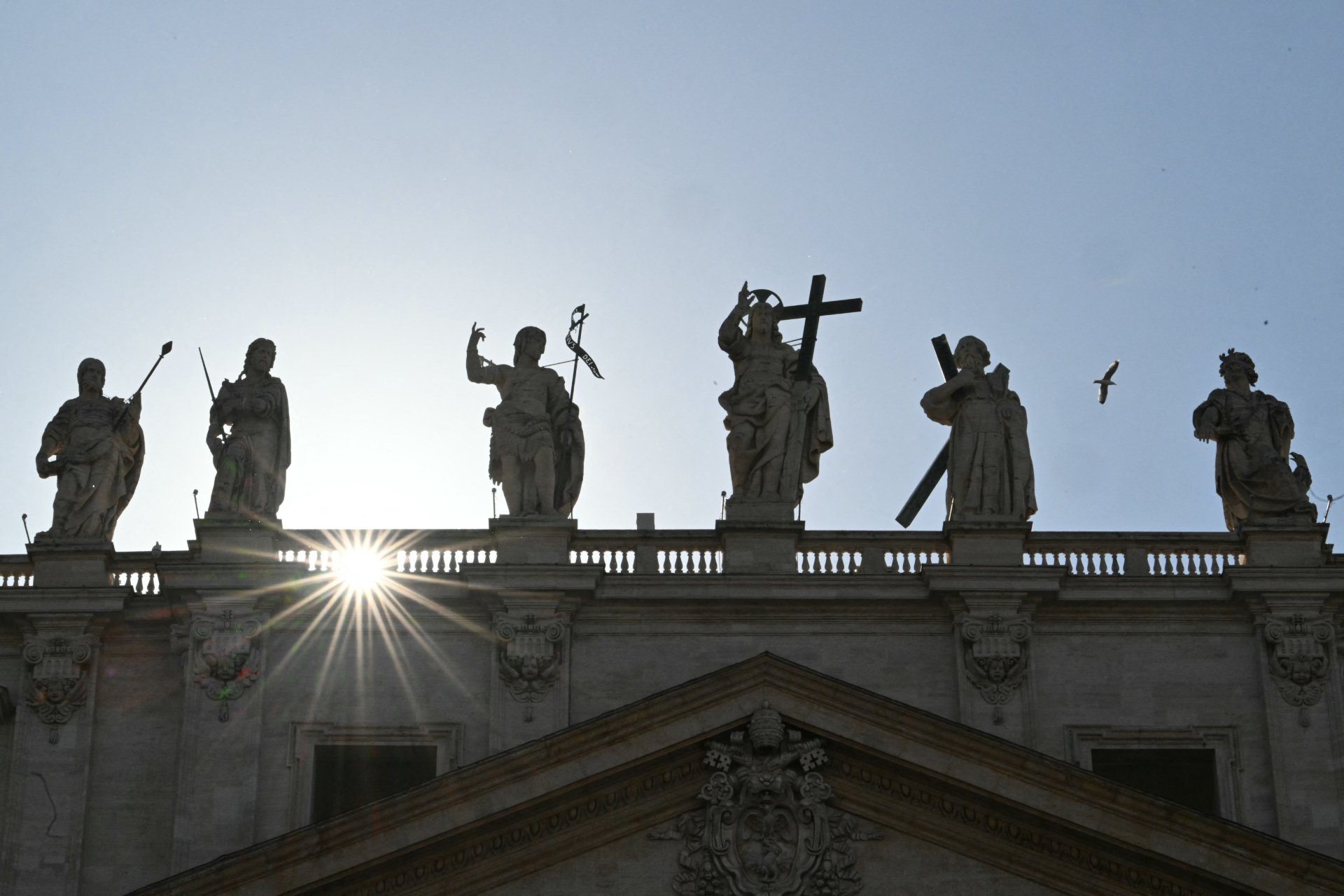
The sun sets behind the basilica at St Peter’s square on the second day of the conclave, at the Vatican, on May 8, 2025. (ALBERTO PIZZOLI/AFP via Getty Images)
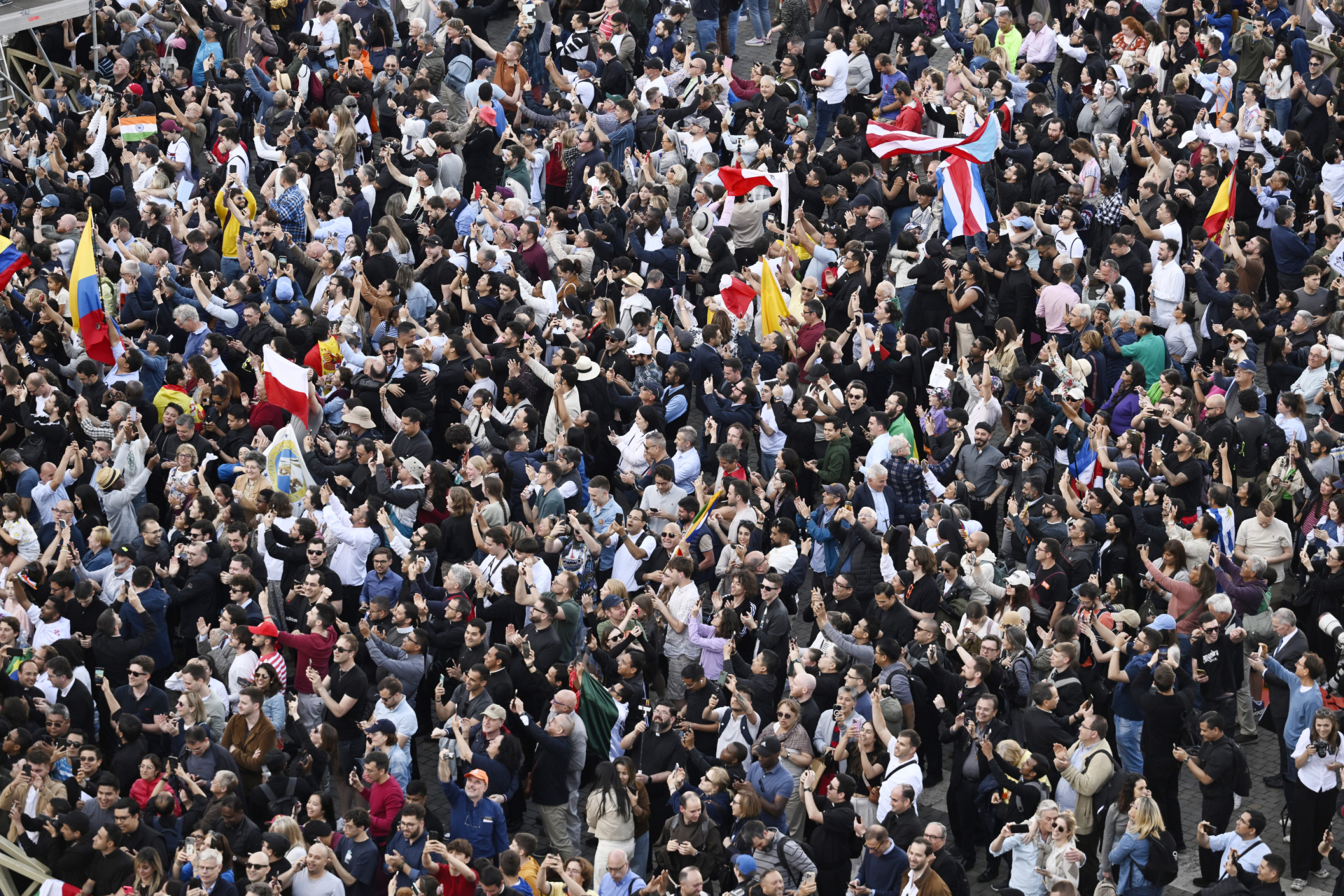
Large crowds celebrate on St Peter’s Square as they witness white smoke after a new pope is elected at the conclave on May 8, 2025 in Vatican City, Vatican. (Antonio Masiello/Getty Images)
Live coverage and commentary from EWTN in St. Peter’s Square:
*** Original reporting from this morning below…
A plume of black smoke rose over the crowds thronging St Peter’s Square late Wednesday, confirming the conclave’s first ballot lacked a two-thirds majority to name a successor to the late Pope Francis, as Breitbart News reported.
One hundred and thirty-three Roman Catholic cardinals from 66 countries, known as “Princes of the Church,” subsequently spent the night sequestered in the Santa Marta guesthouse, and were to seek divine inspiration at private mass early Thursday before embarking on a second day of voting, AFP notes.
Of the sequestered churchmen, 52 hail from Europe, 23 Asia, 17 South or Central America, 17 Africa, 20 North America, and four Oceania.
If Thursday morning’s first secret ballot fails again to identify a clear winner from the crowded pack, a second vote will be held. If there is no consensus again, two more votes will be held in the afternoon.
The cardinals will remain locked behind closed doors and cut off from the world until the newly elected 267th pontiff has a clear blessing to lead the world’s 1.4 billion Catholics.
The chosen elite are sworn to secrecy about the centuries-old process under threat of excommunication.
AFP reports in practice, the previous two conclaves – the 2005 election of Benedict XVI and of Francis in 2013 – lasted upwards of 48-hours.
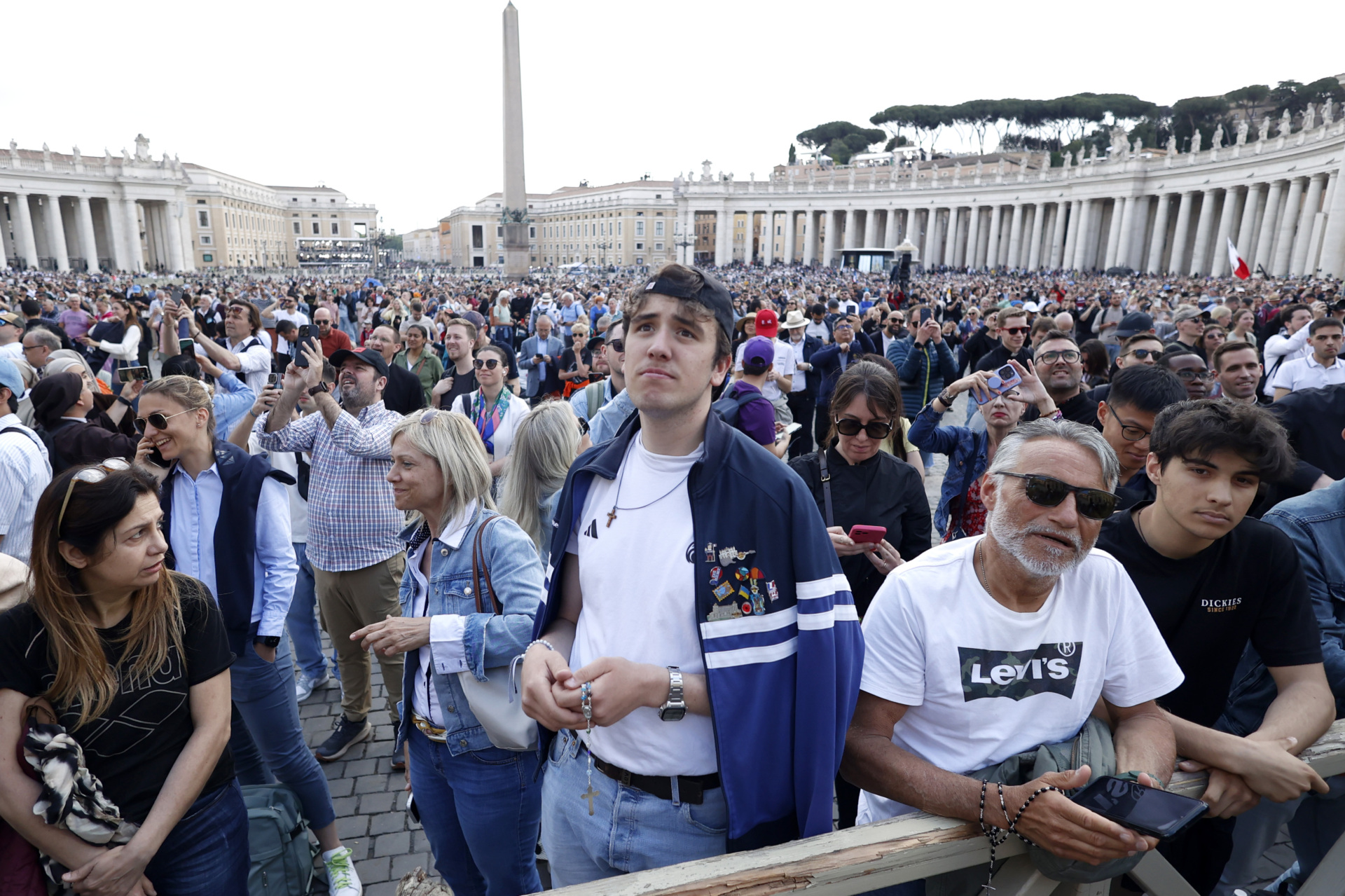
Faithful stand in St. Peter’s Square during the second day of the Conclave, at the Vatican on May 8, 2025. Black smoke emerged from the chimney atop the Sistine Chapel, where cardinal electors are gathered to elect the 267th Pope of the Catholic Church, signaling the failure of the morning ballots of the first full day of voting. (Photo by Riccardo De Luca/Anadolu via Getty Images)
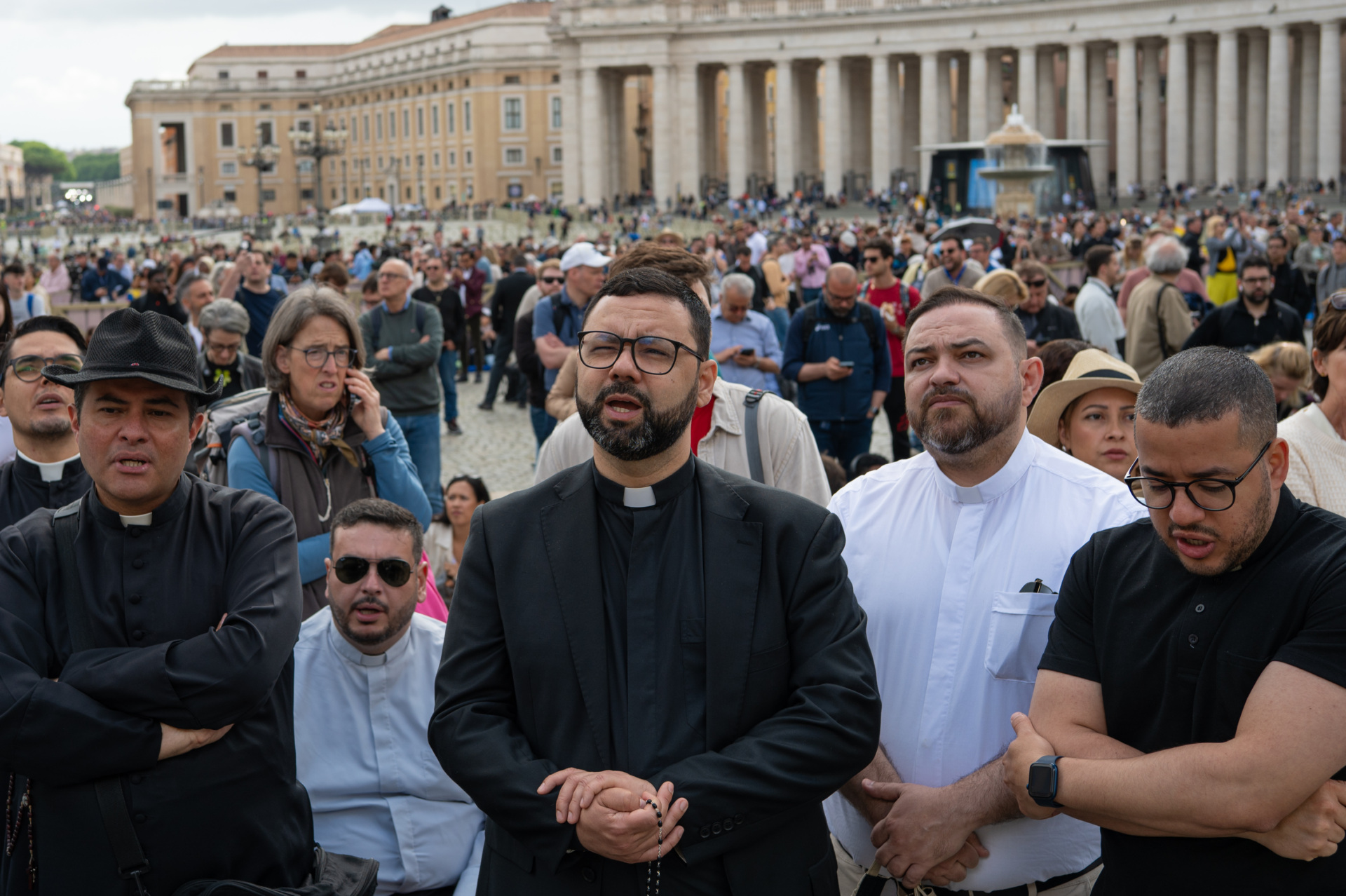
Priests pray in St. Peter’s Square on the second day of the conclave, in the Vatican, on May 8, 2025. (Photo by Massimo Valicchia/NurPhoto via Getty Images)
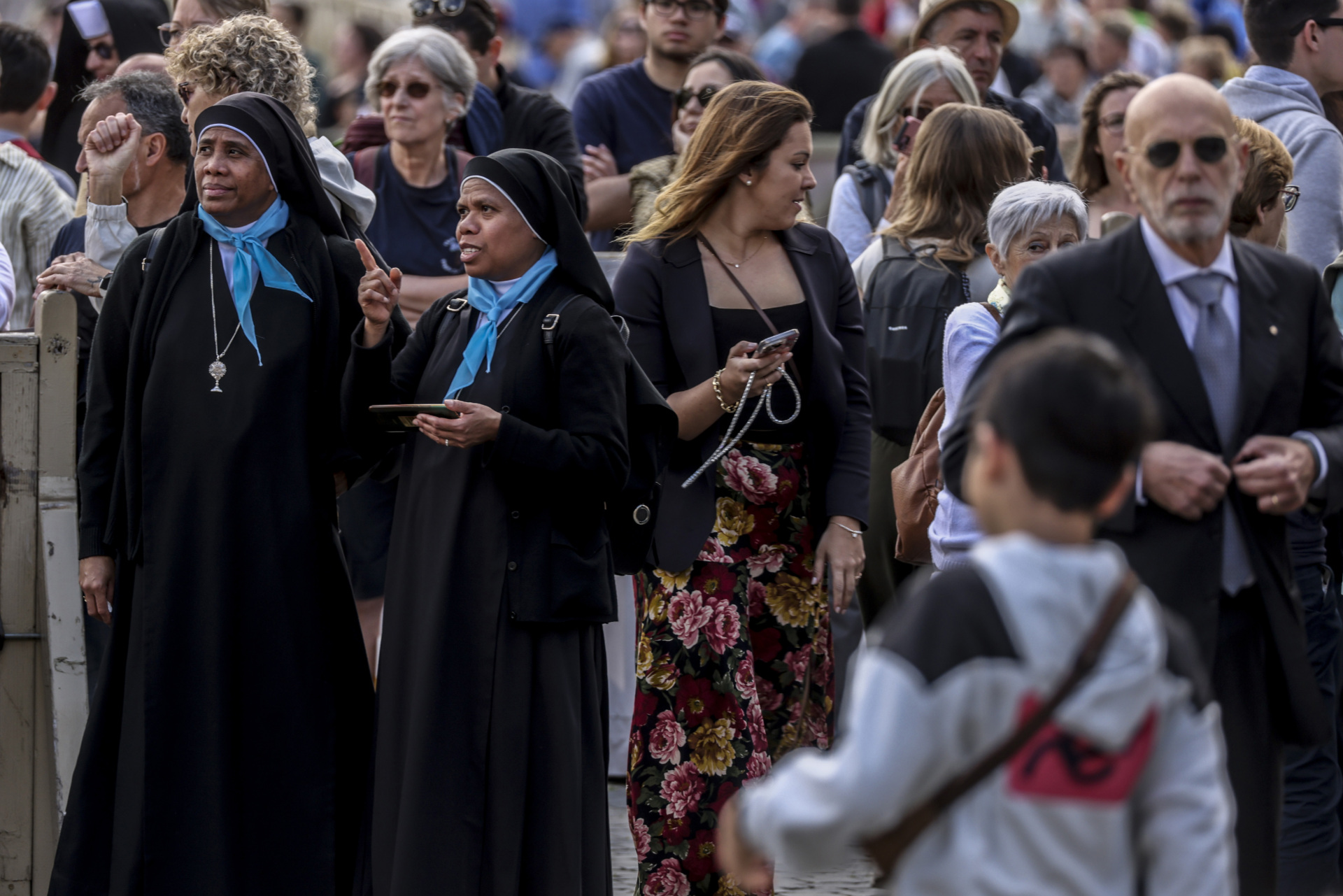
Nuns await for the election of the new Pope in St. Peter’s Square, during the second Day of the Conclave, on May 8, 2025 in Vatican City. (Alessandra Benedetti – Corbis/Corbis via Getty Images)
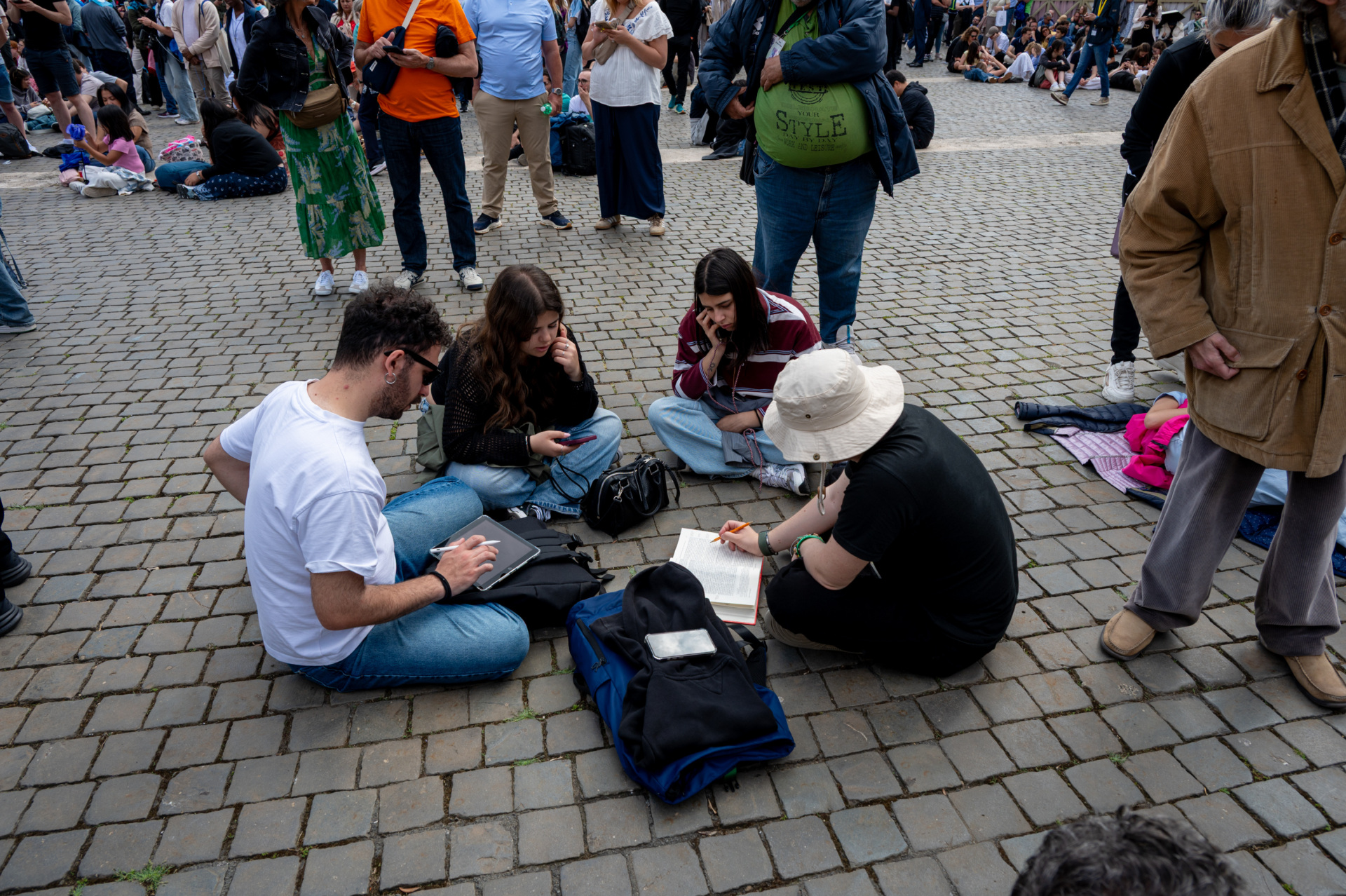
Faithful wait in St Peter’s Square on the second day of the conclave in the Vatican on May 8, 2025. (Massimo Valicchia/NurPhoto via Getty Images)

Nuns pray and wait for white smoke from the Sistine Chapel chimney indicating Cardinals have elected a new Pope in St. Peter’s Square on May 7, 2025 in Vatican City, Vatican. (Laura Lezza/Getty Images)
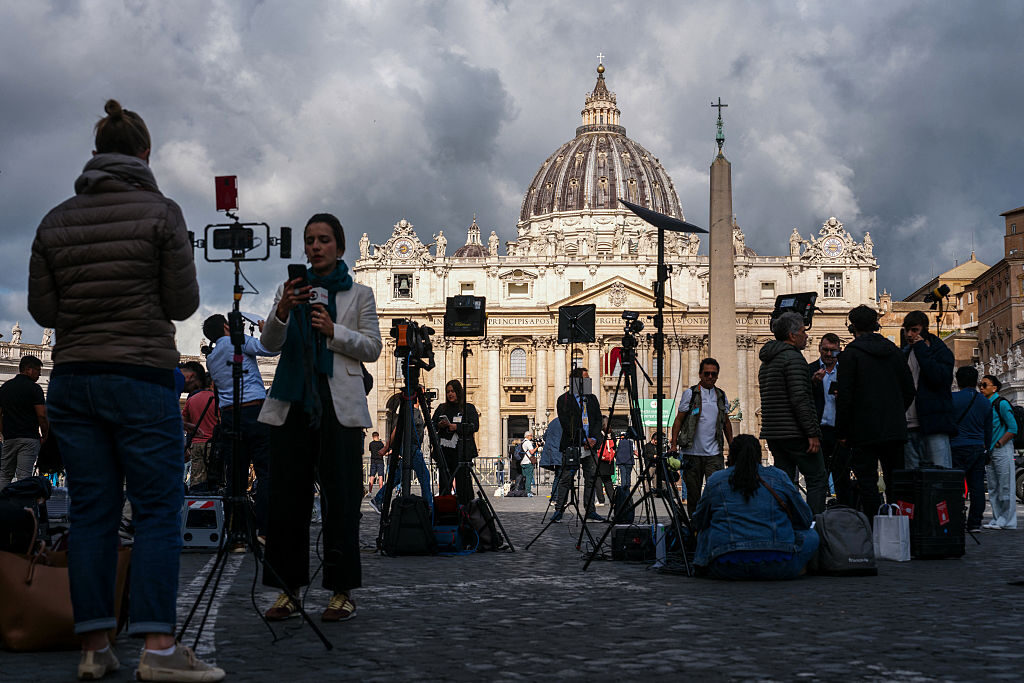
Journalists work at St Peter’s Square with the St Peter’s basilica in the background, ahead of the second voting session of the conclave, in the Vatican on May 8, 2025. (DIMITAR DILKOFF/AFP via Getty Images)
In the 20th and 21st centuries, conclaves have never lasted longer than five days, as was the case for Pope Pius XI’s election in 1922, which required 14 ballots.
Locked away to avoid distraction and leaks, their only means of communicating the outcome of their votes is by burning their ballots with chemicals to produce smoke.
It is black if there is no decision, or white if they have chosen a new pope.
If a pope has not been selected by Saturday afternoon, the cardinals will take Sunday off for prayer, quiet reflection and informal discussion.
AFP contributed to this report.
Read the full article here
